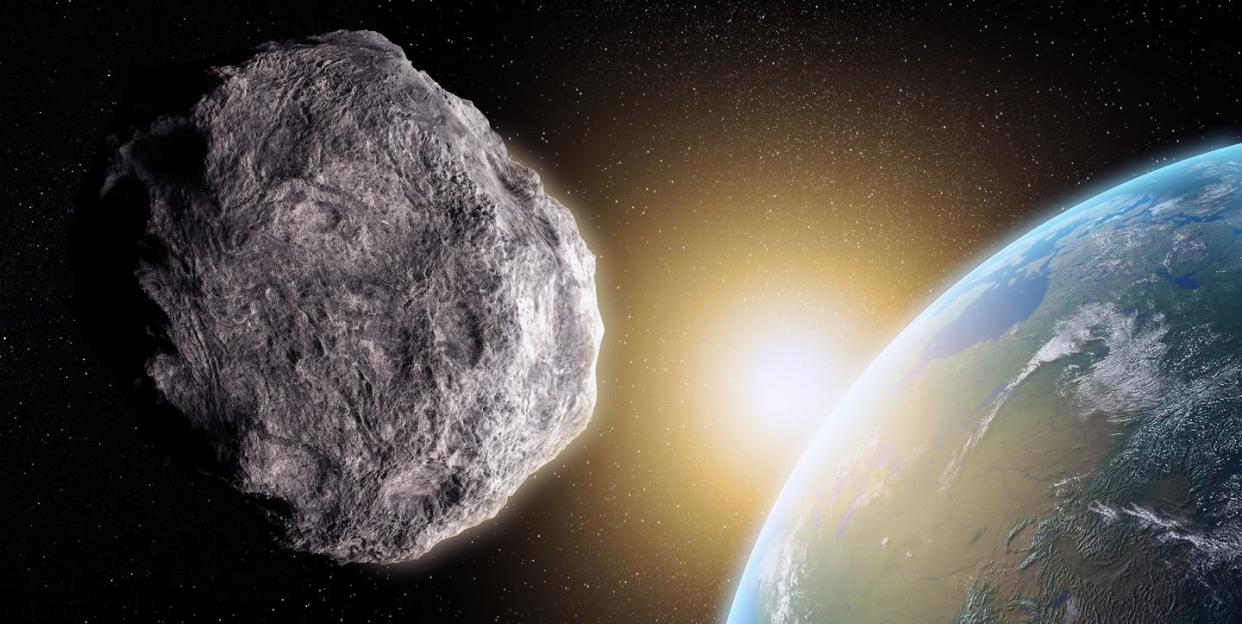A Massive, 'Potentially Hazardous' Asteroid Is Zooming Past Earth Tonight

A “potentially hazardous” asteroid will zoom past Earth on Tuesday evening.
Asteroid 7482 is over half a mile wide, but will thankfully pass Earth from about 1.2 million miles away.
You can view the space rock through a six-inch telescope, or check out a livestream of the event.
A potentially hazardous asteroid called 7482 (1994 PC1) will pass close enough to Earth today that you’ll be able to see it with a small telescope. The asteroid is more than half a mile wide, or about the height of the Burj Khalifa skyscraper in Dubai. Thankfully, it will pass Earth from about 1.2 million miles away, or about five times as far away from our planet as the moon.
🔭 You love astronomy. So do we. Let's explore our galaxy together.
All asteroids orbit the sun, and, depending on their routes, pass near Earth periodically. The Sentry impact-monitoring system of the NASA Jet Propulsion Laboratory’s Center for Near-Earth Object Studies in Pasadena, California computes high-precision orbits of celestial objects, including asteroids. The system accurately predicts potential impacts between these objects and Earth across the span of the next 100 years; as part of that work, it has been monitoring Asteroid 7482. The last time this rock got close to Earth was in 1933, and it was 700,000 miles away. Its next relatively close encounter is almost 200 years away.
How Does NASA Track Asteroids?
NASA tracks asteroids and comets with survey telescopes that never stop scanning our cosmic neighborhood. If multiple pictures of the same spot in the sky show quick movements, computers check the spot against a database of known celestial objects, a scenario depicted at the start of the disaster film, Don’t Look Up. Sometimes, the object turns out to be a brand-new space rock; other times, NASA flags the objects for closer observation if they’re projected to swing close by.
So far, survey telescopes have found 28,000 near-Earth asteroids, meaning their orbits take them within 93 million miles of our planet, on average the same distance we are from the sun. NASA keeps a handy list of the five closest asteroids predicted to pass by Earth, including Asteroid 7482. The next four will be significantly smaller than Asteroid 7482, and about twice as far away. Check out the live positions and speeds of all of our solar systems’ asteroids with NASA’s Eyes on Asteroids.
How Does NASA Deal With Hazardous Asteroids?
Potentially hazardous asteroids are the ones larger than 490 feet wide and that also fly within 4.65 million miles of Earth. If one did hit us, it could cause significant damage to entire cities or coastlines. Just in case we find one of these immense rocks headed straight for our planet, NASA is researching the possibility of shoving it aside with a probe.
The Double Asteroid Redirection Test, or DART, left Earth in November and is scheduled to collide with Dimorphos—part of a double-asteroid system that orbits the sun just beyond Mars—in late September. Dimorphos is not considered a threat to Earth, but if DART alters its current trajectory, it would mean we have the capability to do the same for a truly dangerous asteroid.
What Time Will Asteroid 7482 Pass By Earth?
The closest approach will be at 4:51 p.m. EST.
Where Can I See the Asteroid?
Because it’s flying so fast, at about 45,000 miles per hour, it will be easy to see this Magnitude 10 point of light moving against a backdrop of stars. As a scale of apparent brightness, the magnitude of luminous objects in the sky can vary from very bright—such as the sun, which registers at magnitude -26.74 (that’s right, it’s a negative number)—to magnitude 1 for the star Sirius, to the dim limit of the Hubble Telescope’s vision, magnitude 30.
Backyard astronomers can spot the asteroid's point of light with a six-inch backyard telescope. When to look depends on your location, however. A site that keeps track of celestial objects can help you pick the best time.
If you don’t have the means or inclination to go outside with a telescope, you can also watch the live show from your couch. The Virtual Telescope Project, an online service of the Bellatrix Astronomical Observatory in Italy, will air a livestream event starting at 3 p.m. EST.
You Might Also Like

